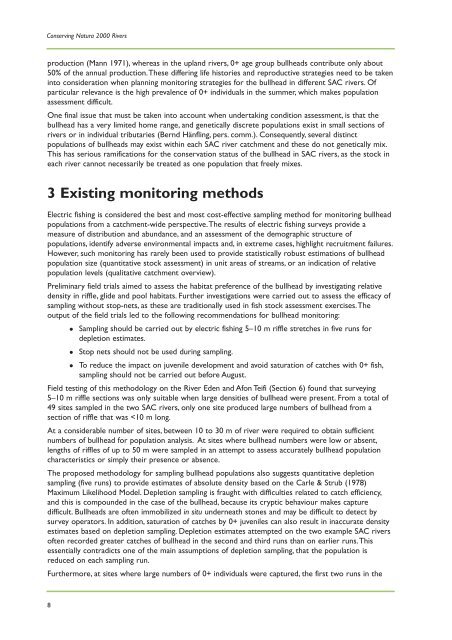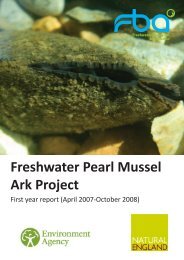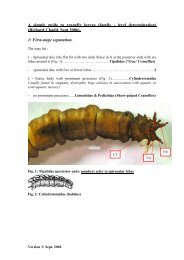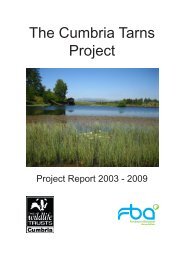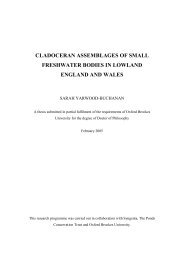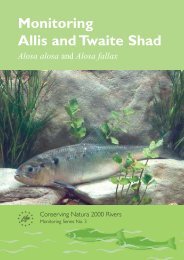Monitoring the Bullhead - European Commission
Monitoring the Bullhead - European Commission
Monitoring the Bullhead - European Commission
You also want an ePaper? Increase the reach of your titles
YUMPU automatically turns print PDFs into web optimized ePapers that Google loves.
Conserving Natura 2000 Rivers<br />
production (Mann 1971), whereas in <strong>the</strong> upland rivers, 0+ age group bullheads contribute only about<br />
50% of <strong>the</strong> annual production.These differing life histories and reproductive strategies need to be taken<br />
into consideration when planning monitoring strategies for <strong>the</strong> bullhead in different SAC rivers. Of<br />
particular relevance is <strong>the</strong> high prevalence of 0+ individuals in <strong>the</strong> summer, which makes population<br />
assessment difficult.<br />
One final issue that must be taken into account when undertaking condition assessment, is that <strong>the</strong><br />
bullhead has a very limited home range, and genetically discrete populations exist in small sections of<br />
rivers or in individual tributaries (Bernd Hänfling, pers. comm.). Consequently, several distinct<br />
populations of bullheads may exist within each SAC river catchment and <strong>the</strong>se do not genetically mix.<br />
This has serious ramifications for <strong>the</strong> conservation status of <strong>the</strong> bullhead in SAC rivers, as <strong>the</strong> stock in<br />
each river cannot necessarily be treated as one population that freely mixes.<br />
3 Existing monitoring methods<br />
Electric fishing is considered <strong>the</strong> best and most cost-effective sampling method for monitoring bullhead<br />
populations from a catchment-wide perspective.The results of electric fishing surveys provide a<br />
measure of distribution and abundance, and an assessment of <strong>the</strong> demographic structure of<br />
populations, identify adverse environmental impacts and, in extreme cases, highlight recruitment failures.<br />
However, such monitoring has rarely been used to provide statistically robust estimations of bullhead<br />
population size (quantitative stock assessment) in unit areas of streams, or an indication of relative<br />
population levels (qualitative catchment overview).<br />
Preliminary field trials aimed to assess <strong>the</strong> habitat preference of <strong>the</strong> bullhead by investigating relative<br />
density in riffle, glide and pool habitats. Fur<strong>the</strong>r investigations were carried out to assess <strong>the</strong> efficacy of<br />
sampling without stop-nets, as <strong>the</strong>se are traditionally used in fish stock assessment exercises.The<br />
output of <strong>the</strong> field trials led to <strong>the</strong> following recommendations for bullhead monitoring:<br />
Sampling should be carried out by electric fishing 5–10 m riffle stretches in five runs for<br />
depletion estimates.<br />
Stop nets should not be used during sampling.<br />
To reduce <strong>the</strong> impact on juvenile development and avoid saturation of catches with 0+ fish,<br />
sampling should not be carried out before August.<br />
Field testing of this methodology on <strong>the</strong> River Eden and Afon Teifi (Section 6) found that surveying<br />
5–10 m riffle sections was only suitable when large densities of bullhead were present. From a total of<br />
49 sites sampled in <strong>the</strong> two SAC rivers, only one site produced large numbers of bullhead from a<br />
section of riffle that was


